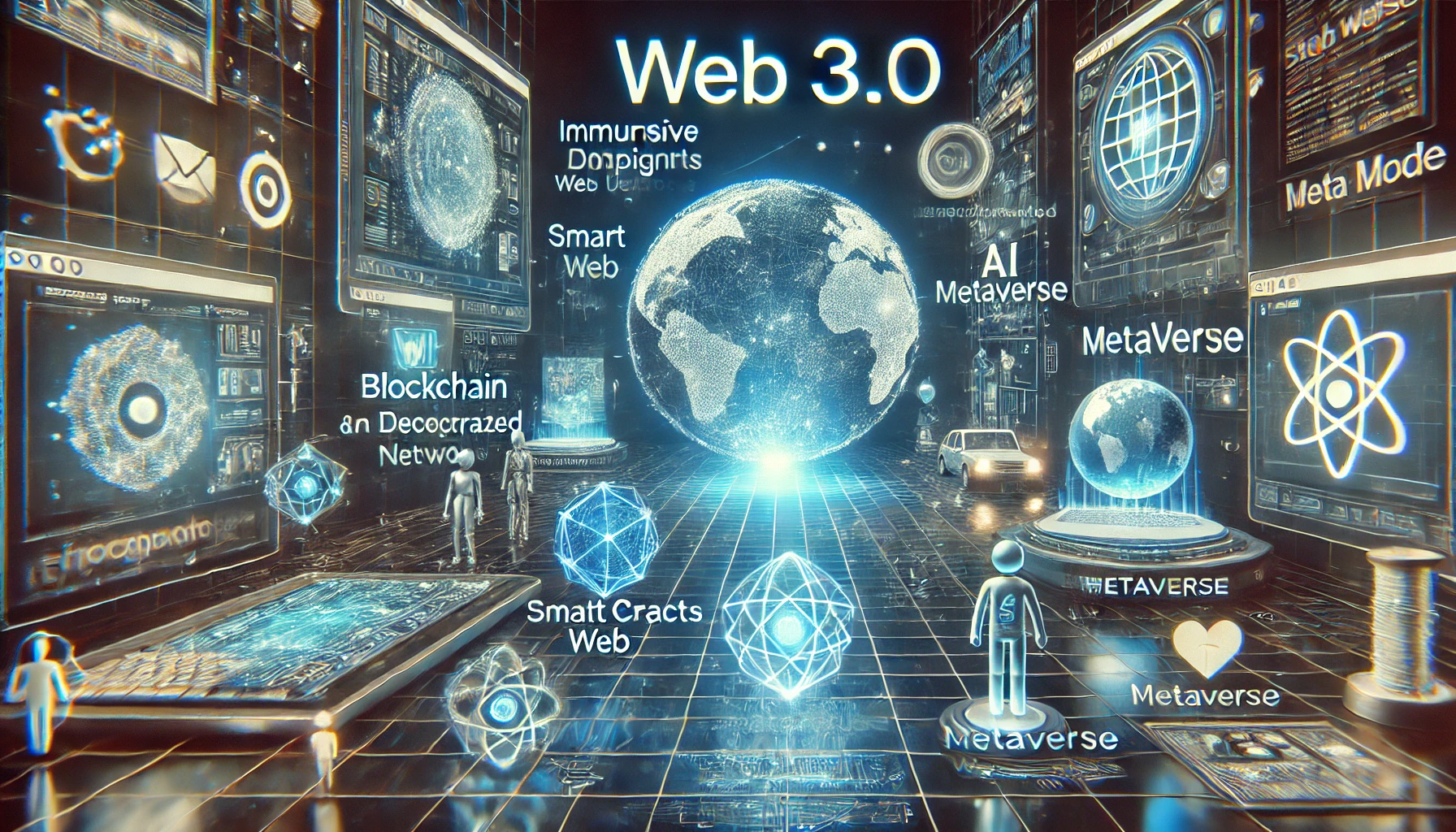Needless to say, Technologies are exotically revolutionizing; however, the notable evolution of the internet has dramatically changed how we interact with digital platforms. With the emergence of Web 3.0, businesses and developers are shifting towards decentralized and user-centric web experiences. The new era of the internet influences custom web development by incorporating AI-driven interfaces, blockchain security, and seamless user experiences.
At Speed Dot 360, we are at the forefront of this transformation, offering mobile-friendly website design solutions that align with Web 3.0 principles. This blog explores how Web 3.0 is reshaping web design and what businesses need to do to stay ahead.
What is Web 3.0?
The third generation of the internet – Web 3.0, is the technology that emphasizes decentralization, automation, and user sovereignty. Unlike its predecessors, Web 3.0 operates on blockchain-based networks, ensuring transparency, enhanced security, and improved user control.
Key Features of Web 3.0:
- Decentralization: Eliminates intermediaries, reducing data breaches and increasing ownership rights.
- Artificial Intelligence & Machine Learning: Enhances website functionality with adaptive algorithms.
- Interoperability: Seamless integration across multiple platforms and devices.
- Blockchain Security: Ensures data integrity and transparency, eliminating unauthorized modifications.
The Tapestry of Web 1.0, 2.0 & 3.0
Web 1.0: The Static Web (1990s – Early 2000s)
Read-only web, popularly regarded as “Web 1.0”, was also referred to as the earliest phase of Internet evolution. Websites were static, with minimal interactivity and basic HTML structures.
Characteristics:
- Static HTML pages with limited user interaction.
- No user-generated content; only companies and developers could publish content.
- Basic design with simple text and images.
Web 2.0: The Interactive Web (Early 2000s – Present)
Web 2.0 introduced dynamic content, social media, and increased interactivity. It shifted from static pages to user-driven platforms where people could create and share content.
Characteristics:
- Social media platforms like Facebook, Twitter, and Instagram.
- Dynamic, database-driven websites enabling real-time interaction.
- Centralized control where companies own and manage data.
Web 3.0: The Decentralized Web (Emerging Era)
Web 3.0 builds upon Web 2.0 but eliminates centralized control, leveraging blockchain and AI to create intelligent, user-centric digital experiences.
Characteristics:
- Decentralization: Blockchain-based transactions eliminate intermediaries.
- Semantic Web: AI and machine learning personalize user interactions.
- Enhanced Security: Smart contracts ensure secure and transparent operations.
Understanding Web 3.0 and Its Impact on Web Design
Web 3.0 is the next stage of internet evolution, characterized by decentralization, machine learning, and seamless user interactions. Unlike Web 2.0, where centralized control dictated content flow, Web 3.0 promotes peer-to-peer connectivity and empowers users through blockchain technology.
Key Features of Web 3.0 Influencing Web Design:
- Decentralization: Websites no longer rely on centralized servers; instead, they operate on blockchain-based networks.
- Artificial Intelligence & Machine Learning: Websites can understand user behavior and personalize content more efficiently.
- Interoperability: Web applications function across multiple platforms without compatibility issues.
- Enhanced Privacy & Security: Blockchain technology ensures data protection and transparency.
Web 3.0 Elements That Transform Web Design
Decentralized Web Hosting & Security
Traditional websites rely on centralized hosting services, making them vulnerable to cyber-attacks. Web 3.0 introduces decentralized hosting, where content is distributed across a blockchain network, increasing security and uptime reliability.
How It Affects Web Design:
- No single point of failure improves website uptime.
- Reduced reliance on third-party hosting services.
- Enhanced data security with blockchain technology.
2. AI-Powered Personalization
AI and machine learning enable custom web development tailored to individual users. Web 3.0 websites use AI to predict user preferences, ensuring dynamic and engaging digital experiences.
Benefits for Web Designers:
- Adaptive design elements based on user behavior.
- AI-powered chatbots for real-time assistance.
- Personalized content recommendations.
3. Integration of Blockchain Technology
Blockchain revolutionizes web design by offering transparency and security. Smart contracts allow automated interactions, reducing the need for intermediaries in transactions.
How It Impacts Design:
- Secure login credentials using blockchain authentication.
- Trust-based transactions without third-party interference.
- Immutable data storage to prevent fraud and hacking attempts.
4. Voice Search & Natural Language Processing (NLP)
With the rise of AI assistants like Alexa and Siri, Web 3.0 is adapting to voice search optimization. Web designers now need to incorporate NLP strategies to ensure websites rank well in voice searches.
Web Design Enhancements:
- Conversational UI for improved user experience.
- Structured data implementation for better search engine ranking.
- Faster access to information using voice commands.
5. Metaverse & Augmented Reality (AR) Integration
Web 3.0 extends beyond traditional website interactions, bringing augmented reality (AR) and the metaverse into web design. Businesses can create immersive virtual experiences, offering customers new ways to engage with brands.
Transformations in Web Design:
- 3D product visualization for e-commerce sites.
- Virtual storefronts for enhanced shopping experiences.
- Interactive metaverse environments for deeper brand engagement.
The Role of Web 3.0 in Mobile-Friendly Website Design
As mobile usage continues to dominate, mobile-friendly website design is no longer an option but a necessity. Web 3.0 pushes for seamless adaptability, ensuring that websites function smoothly across devices.
Enhancements in Mobile Web Design:
- Progressive Web Apps (PWAs) for faster loading times.
- AI-driven content adaptation for personalized browsing.
- Touch-free navigation through voice search optimization.
Organizations that fail to spearhead for mobile risk losing their competitive edge in the Web 3.0 era.
Web 3.0 and Front-End Development Services
The demand for front-end development services has skyrocketed with Web 3.0. Developers must focus on interactive, fast, and scalable web applications that offer exceptional user experiences.
How Front-End Development is Evolving:
- Use of WebAssembly for high-performance web applications.
- AI-powered interfaces for intuitive user interactions.
- Blockchain-driven authentication for secure login systems.
By leveraging Web 3.0 technologies, businesses can build highly responsive websites that cater to the needs of modern users.
The Future of Digital Branding with Web 3.0
A strong digital identity is crucial in the Web 3.0 era. A digital branding agency must evolve its strategies to incorporate blockchain-based authentication, AI-driven marketing insights, and immersive metaverse branding.
How Web 3.0 Influences Branding:
- NFT-Based Brand Assets: Unique digital assets that offer exclusive brand ownership.
- Decentralized Identity Verification: Secure user authentication for brand trust.
- Immersive Brand Engagement: AR and VR experiences to connect with audiences.
Brands that embrace these Web 3.0 innovations are predicted to scale in the highly competitive digital landscape.
How Speed Dot 360 is Leading the Web 3.0 Revolution
At Speed Dot 360, we specialize in integrating Web 3.0 technologies into web design, offering cutting-edge custom web development solutions that align with the evolving digital landscape.
Why Choose Us?
- Expertise in mobile-friendly website design with AI-driven adaptability.
- Secure blockchain-based authentication for enhanced website security.
- Interactive front-end development services tailored for seamless user experiences.
- Advanced digital branding agency solutions for Web 3.0 businesses.
Partner with Speed Dot 360 today and future-proof your online presence in the era of Web 3.0.
Conclusion
Web 3.0 is revolutionizing the way we design and interact with websites. From decentralized hosting and blockchain security to AI-driven personalization and immersive metaverse experiences, the future of web design is here.
Businesses that embrace Web 3.0 principles will gain a competitive advantage, providing users with seamless, intelligent, and engaging digital experiences. If you’re looking to upgrade your website for the Web 3.0 era, Speed Dot 360 is here to help with custom web development, mobile-friendly website design, and cutting-edge front-end development services.





